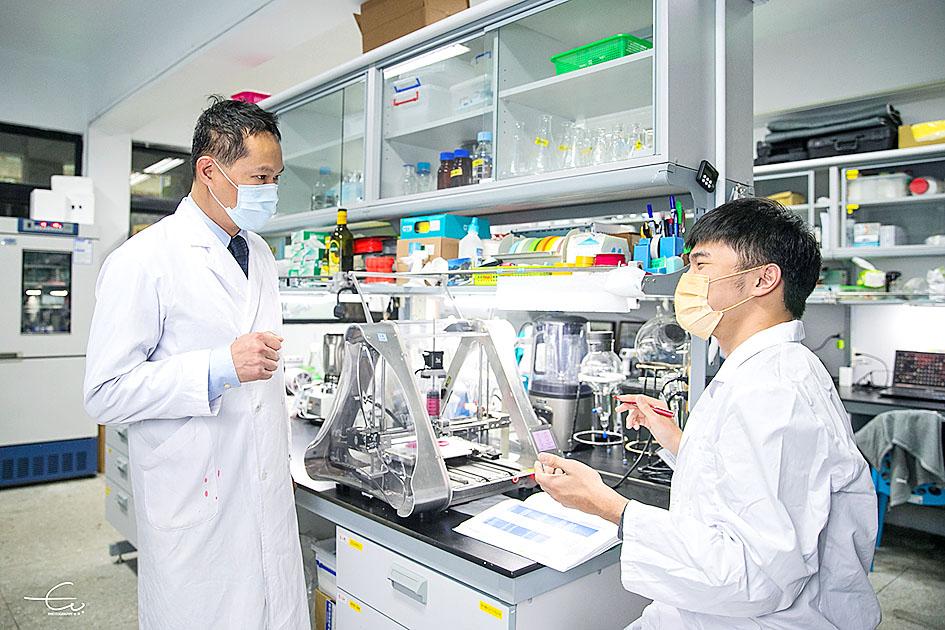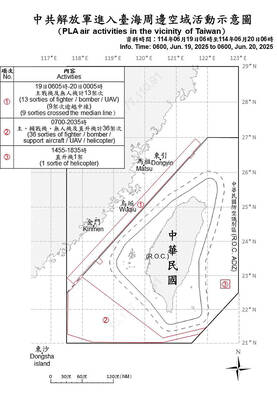National Taiwan Ocean University Department of Food Science professor Lin Yung-kai (林詠凱) and student Tsai Cheng-rong (蔡承融) have developed an “artificial steak” using 3D printing technology, the university said in a statement on Thursday.
The vegetarian edible is made from egg albumen, pea protein, gellan gum, sodium alginate and other ingredients, the university said.
The university has already applied for a US patent for the technology, it said.

Photo courtesy of National Taiwan Ocean University
The artificial “muscle tissue” forming the “steak” can be printed in varying textures, allowing people with poor dental faculties to “enjoy the nutritious delicacy,” it said.
Many elderly people have difficulty eating and might face malnutrition because their teeth have decayed or they find it hard to swallow, it said.
As 3D printing technology can quickly produce food with an ideal shape and texture, it is likely that the technology could revolutionize the way that food is created, the statement quoted Lin as saying.

Photo courtesy of National Taiwan Ocean University
The challenges of developing the 3D-printed “steak” lie in shaping and stacking proteins, and mimicking muscle tissue, Lin said.
Apart from 3D printing, the artificial steak can also be made by microwaving a special powder blended with water, the university said.
The dish can be “customized” by calculating the ideal formula for age groups using artificial intelligence, Lin said in the statement.
The low cost of the ingredients might help to solve the global food crisis and alleviate the impact of animal husbandry on the environment, he said.
As people become more aware of the health issues of eating meat, diets consisting of plant-based proteins are becoming more important, the university said, adding that the beef supply chain is still recovering from the effects of restrictions amid the COVID-19 pandemic.
Lin and Tsai’s research has been published on the Web site of the international journal Future Foods, the university said.

A year-long renovation of Taipei’s Bangka Park (艋舺公園) began yesterday, as city workers fenced off the site and cleared out belongings left by homeless residents who had been living there. Despite protests from displaced residents, a city official defended the government’s relocation efforts, saying transitional housing has been offered. The renovation of the park in Taipei’s Wanhua District (萬華), near Longshan Temple (龍山寺), began at 9am yesterday, as about 20 homeless people packed their belongings and left after being asked to move by city personnel. Among them was a 90-year-old woman surnamed Wang (王), who last week said that she had no plans

China might accelerate its strategic actions toward Taiwan, the South China Sea and across the first island chain, after the US officially entered a military conflict with Iran, as Beijing would perceive Washington as incapable of fighting a two-front war, a military expert said yesterday. The US’ ongoing conflict with Iran is not merely an act of retaliation or a “delaying tactic,” but a strategic military campaign aimed at dismantling Tehran’s nuclear capabilities and reshaping the regional order in the Middle East, said National Defense University distinguished adjunct lecturer Holmes Liao (廖宏祥), former McDonnell Douglas Aerospace representative in Taiwan. If

TO BE APPEALED: The environment ministry said coal reduction goals had to be reached within two months, which was against the principle of legitimate expectation The Taipei High Administrative Court on Thursday ruled in favor of the Taichung Environmental Protection Bureau in its administrative litigation against the Ministry of Environment for the rescission of a NT$18 million fine (US$609,570) imposed by the bureau on the Taichung Power Plant in 2019 for alleged excess coal power generation. The bureau in November 2019 revised what it said was a “slip of the pen” in the text of the operating permit granted to the plant — which is run by Taiwan Power Co (Taipower) — in October 2017. The permit originally read: “reduce coal use by 40 percent from Jan.

‘SPEY’ REACTION: Beijing said its Eastern Theater Command ‘organized troops to monitor and guard the entire process’ of a Taiwan Strait transit China sent 74 warplanes toward Taiwan between late Thursday and early yesterday, 61 of which crossed the median line in the Taiwan Strait. It was not clear why so many planes were scrambled, said the Ministry of National Defense, which tabulated the flights. The aircraft were sent in two separate tranches, the ministry said. The Ministry of Foreign Affairs on Thursday “confirmed and welcomed” a transit by the British Royal Navy’s HMS Spey, a River-class offshore patrol vessel, through the Taiwan Strait a day earlier. The ship’s transit “once again [reaffirmed the Strait’s] status as international waters,” the foreign ministry said. “Such transits by